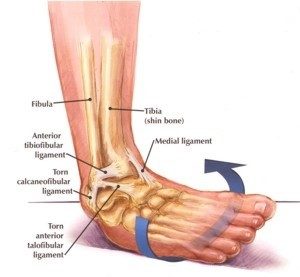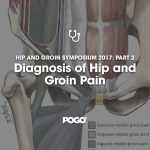Case Study 1: Outcome Measures in Chronic Ankle Instability
Case Study 1: Outcome Measures in Chronic Ankle Instability
Senior physio Bruno shares around the measures that can be used with chronic ankle instability.
Subjective Examination
A 42 years old stunt performer for action movies presented to a private Practice complaining of sore right ankle following an acute sprain done 3 weeks prior. He reported that his General Practitioner had requested X-rays and an MRI. His mechanism of injury was jumping from a 3 meters’ platform holding hands with a co-worker, landing onto his colleague’s foot and consequently rolling his foot outwards. X-rays were clear; however, the MRI revealed full disruption of the ATFL + CFL ligaments associated with mild bone marrow oedema of the medial talocrural joint, which supported the described mechanism of action. Those ligaments are important lateral stabilisers for the ankle joint (figure 1).

General health: non-smoker, occasional alcohol intake, of good health.
Past medical history: No history of previous injuries to the right ankle or previous known functional deficits.
Sports: surfing, stand-up paddling, sky diving, hiking.
Social: married and no children
Objective Examination
Observation revealed an unaided antalgic gait with decreased loading time on mid-stance phase and decreased push-off. Moderate swelling around the ankle joint and moderate bruising.
Active range of motion (AROM) for dorsiflexion and plantarflexion were restricted to 50% of the contralateral side. Active eversion ROM preserved, peroneals’ strength grade 4. Inversion was painful at the end of passive ROM and AROM.
Palpation of the lateral ankle was painful, notably over the ATFL and CFL proximal insertion point onto the lateral malleolus.
Special tests: Ankle anterior drawer test +ve, Talar tilt +ve
Functional tests: Single leg hop = unable, Single heel lift = unable, Double legged squat = painful 6/10 and restricted mid-range.
Patient Specific Functional Scale: Running 0/10, Jumping 0/10, Climbing 2/10, Surfing 0/10, Hiking 0/10 – where 10 equals full function.
Patient’s goals:
1 – to be fit for work duties in 3 months’ time;
2 – return to sports.
Part B – List of Potential Outcome Measures
Lower Extremity Functional Scale (1-3)
Star Excursion Balance Test (4-8)
Lower Quarter Y-balance test (9, 10)
Balance Error Scoring System (11, 12)
Foot and Ankle Disability Index (13-15)
Foot and Ankle Ability Measures (16)
Numeric Pain Rate Scale (17-20)
The Patient Specific Functional Scale (21)
Foot and Ankle Outcome Score (22)
Cumberland Ankle Instability Tool (23)
Active Ankle Range of Motion (comparison between affected and unaffected sides, pain levels)
Passive Ankle Range of Motion (comparison between affected and unaffected sides, pain levels)
Single heel lift affected side (comparison between affected and unaffected sides, quality of movement, pain levels)
Single leg hop test (comparison between affected and unaffected sides, distance, quality of movement, pain levels)
Squat (quality of movement, depth, pain levels)
Part C – Primary Outcome Measure Chosen
The Foot and Ankle Disability Index has been selected as a primary outcome measure for this clinical scenario.
Foot and Ankle Disability Index
http://www.orthopaedicscore.com/scorepages/foot_and_ankle_disability_index_fadi.html
Psychometric Properties (24):
Foot and Ankle Disability Index (FADI) is a region-specific outcome measure that addresses activities of daily living, functional performance, occupational performance, pain and sleep. It also incorporates a Sports module which assess skills involved in higher demand activities. It is a patient reported outcome, which takes 5 minutes or less to be administered, free of costs or specific training. It has been tested in a young population with self-reported chronic ankle instability.
Its Standard Error of Measurement (SEM) at 6 weeks interval has been reported by Hale and Hertel (14) as SEM 1.31 for FADI and 4.43 for FADI Sport. The same authors have found the Minimal Detectable Change (MDC) to be 3.6 (95%CI) for FADI and 12.3 (95%CI) for FADI Sport at 6 weeks. Minimally Clinically Important Difference has not been established.
Eechaute, Vaes (13), found Excellent Test-retest Reliability for FADI and FADI sport in their Systematic Review of Chronic Ankle Instability (CAI) studies. Intrarater and Interrater Reliability was also found to be excellent with ICC 0.92 and 0.93 at 6 weeks for FADI and FADI Sport respectively (14).
No ceiling effects were established for FADI, floor effects are not present in this outcome (13). Responsiveness has varied between authors with effect sizes varying from moderate to large (13, 14, 25).
Discussion
Different aspects support the choice of the FADI + FADI Sports in this clinical scenario. Firstly, it evaluates dimensions that are relevant to the patient’s injury, physical impairments, activities and goals. The nature of his occupation is physically highly demanding. As a stunt performer, he is expected to negotiate uneven terrain; jump and land from various heights; climb and descend walls, ladders and obstacles; be prepared to drive vehicles at high speeds and deal with emergency situations. Overall, a high-risk job that requires elevated levels of physical performance.
This individual main goal is to be fit for duties at 3 months’ post injury. FADI and FADI Sports module are both reliable measures to be taken at 6 weeks intervals, and the MDC has been established with 95% Confidence Interval by two authors (13, 14). Clinically, I can trust this outcome measure to detect change in a short period of time (6 weeks), and use its result to aid my clinical decision making in supporting or not his safe return to work at 3 months’ post injury. Also, its Test-retest reliability and intra-rater reliability has been found to be excellent by Eechaute, Vaes (13), Hale and Hertel (14). Hence, the chances of having measurement errors between two points is time, negatively influencing my evaluation and clinical decision is small.
The literature does not define what is the minimally clinically important difference (MCID) for this outcome measure (24). Wells, Beaton (26) report in their paper the challenges in finding the MCID for the individual. Cook (27) advances the discussion further by raising issues regarding the variability of MCID values according to the methods used. Moreover, his paper highlights the negative consequences of using MCID values out of proper context for clinical decision making.
Therefore, given the specific goals of this patient and the nature of his job, the MCID bar for his scenario would have to be quite high. The concept of “minimally clinically important” in this case implies either fit for duties, meaning able to perform at high levels through complex movement such as cutting, pivoting and jumping, or not fit. So, based on normative data of control subjects and subjects reporting Chronic Ankle Instability from Gribble and Robinson (28), Hubbard, Hertel (29), Sedory, McVey (30); I would expect a minimal of 95% score on FADI and FADI Sports module to be the MCID for this patient. Scores below that percentage would likely lead to a negative decision regarding his suitability to return to work at 3 months. As per his secondary goal of returning to sports, a similar rationale would be applied to enable safe sports practice.
Bruno Rebello (APAM)
Physiotherapist

Featured in the Top 50 Physical Therapy Blog









Unfortunately, forty two years old stunt performer found an injury of ankle. So now he should prefer the treatment of MRI than X-rays. Magnetic scanning gives you more clear and flawless image so ignore its high price. Moreover, it is so expensive but it can fulfill the requirements of patient. If he wants to get a rapid cure then he should follow the instructions of physicians and doctors.
Well written Samuel,
I hope you are on track and staying well.
Regards Brad Beer